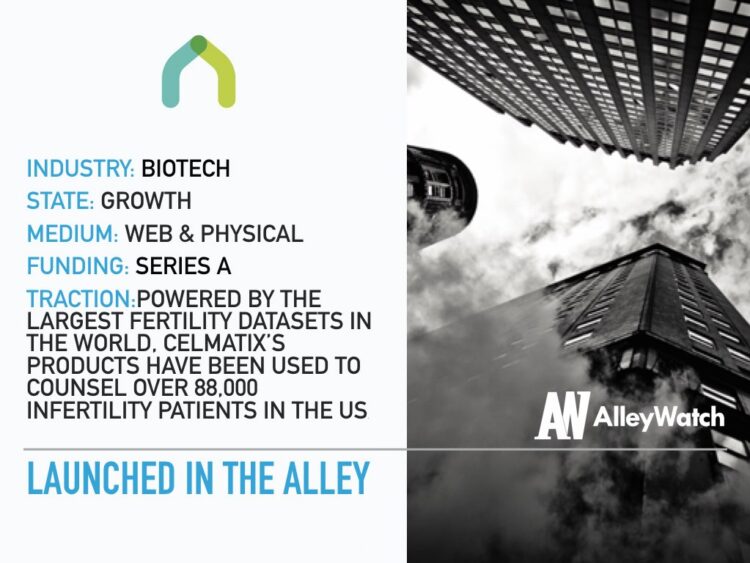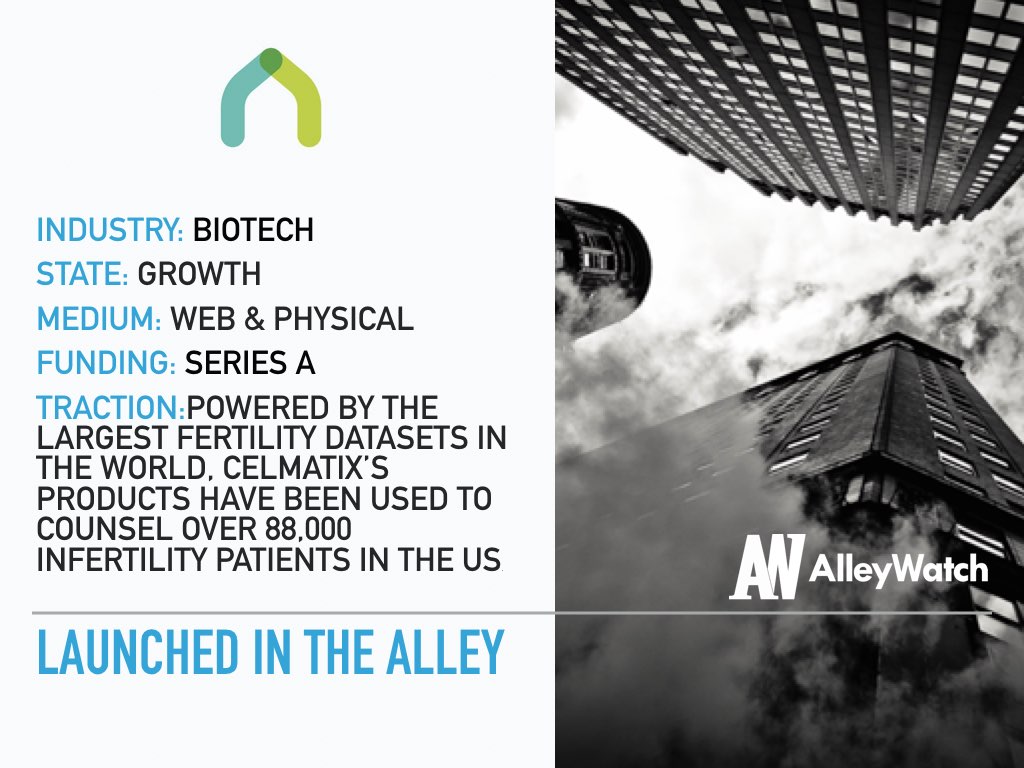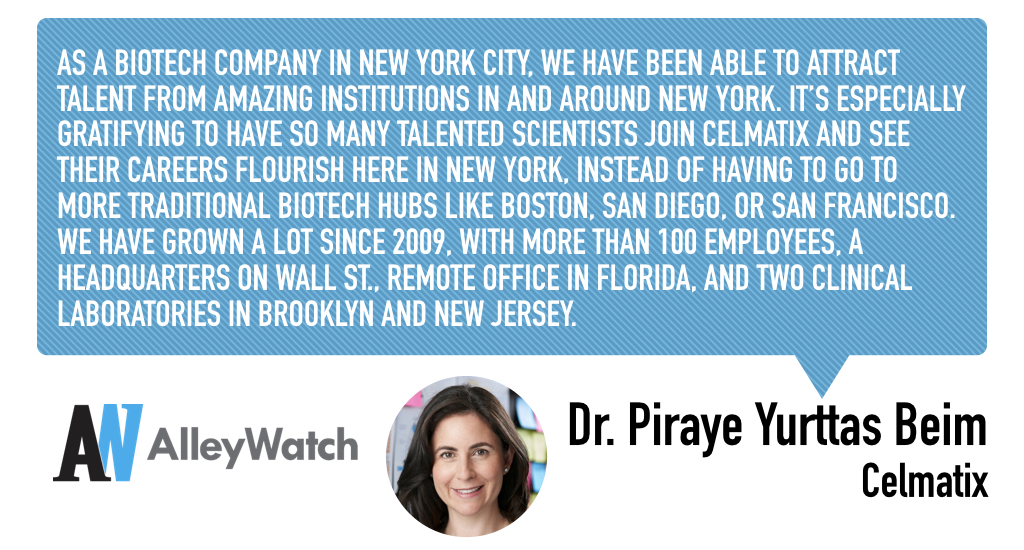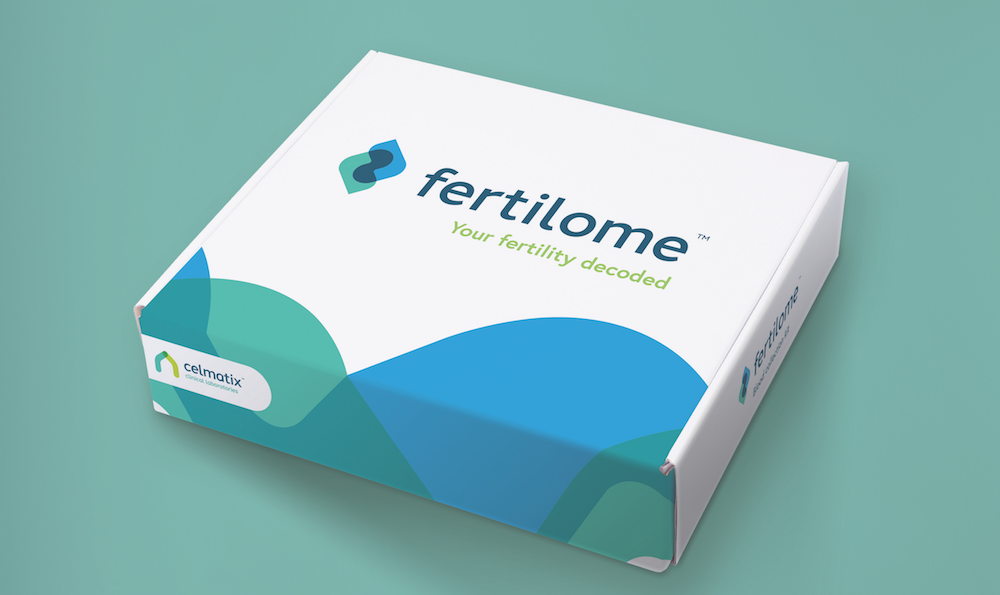Infertility affects about 10% of women and unfortunately, physicians are ill-equipped to prescribe a personalized regiment for fertility treatment. Looking to tackle this issue from a data-driven perspective, Celmatix provides genetic insights that empower women and their physicians to make more informed, proactive, and personalized reproductive health decisions. The startup has already developed two proprietary products that are making a significant impact on understanding reproductive health.
AlleyWatch sat down with Dr. Piraye Yurttas Beim to discuss the company’s latest developments and learn more about its future plans.
Tell us about Celmatix.
Celmatix is a next-generation women’s health company that uses data and genetic insights to give women better, more personalized information about their reproductive health. Celmatix provides women with tools to help them make fertility decisions based on a better understanding of what is right for their own biology and goals.
Celmatix has developed two proprietary products, the Fertilome test, the world’s first multigene panel test that reveals how a woman’s DNA may impact her reproductive health, and Polaris, a real-time predictive analytics platform in use at leading fertility clinics across the U.S. that helps physicians optimize patient outcomes and improve the patient experience.
At a time when data science and genomics are revolutionizing the world in healthcare and beyond, women’s health has fallen vastly behind. Celmatix is leading the charge in bringing personalized and precision medicine paradigms to women’s health, starting with reproductive health. We have also grown right on the bleeding edge of the rise of biotech in New York City. This has meant breaking down barriers across the board from generating a talent pipeline, to real estate, to regulatory strategy (New York has the most stringent health-related regulatory requirements of any other state in the US).
We rose above these hurdles to develop Polaris, a revolutionary software product that has been used to counsel nearly 90,000 infertility patients and the world’s first multigene panel test for female reproductive conditions, the Fertilome test, which also became the first test of its kind to be approved by the New York State Department of Health.
What market does Celmatix target and how big is it?
The women’s health market is, in theory, one of the biggest addressable markets in healthcare. Right now, we are focused on reaching customers through fertility specialists, but our products have the potential to impact the lives of the nearly 50 million women of reproductive age in the US. We are also exploring opportunities for international expansion, which opens up our addressable market dramatically. Virtually every human on earth either has or wants to have the option of having a child one day. We believe that every woman deserves to have the tools to be proactive in maximizing her fertility potential.
Millennial women are poised to be the largest generation of mothers in human history. We know from our research that millennial women are concerned about their fertility: 87% of them think about their fertility and ability to have children, and 75% of them have discussed or would like to discuss fertility with their OB-GYN. But we also know that most millennial women are planning to have kids later in life: Nearly half of women surveyed would like begin family building after 30, and 20% would like to have their first child at 35 or older.
Many experts believe that these trends will bring on the same “fertility crisis” in the US that has already begun in countries like Japan. Millennial women are technology natives; therefore, we have found that many assume that reproductive healthcare technology will keep up with their plans to have children on average much later than any generation before. The products we have created are the first step to giving women the control they want because knowledge is power. Right now, many women are rolling the dice with their fertility by waiting until their 30’s to start their families. We are offering a different solution: Use technology to learn more about your body so that you can better plan for your future and more easily create the life you want when the time comes. The market potential for our genetic test is north of $20B in the US alone.
What is the business model?
The Fertilome genetic test is ordered by physicians, paid for out-of-pocket by women, and run in our CLIA labs in New York and New Jersey. Our cloud-based Polaris SaaS platform is licensed by fertility clinics and used to counsel patients at no extra cost to the patient. Now that we have assembled the largest single, usable source of real-world evidence data and genomic information related to reproductive health in the world, we are beginning to work with partners in other areas of the healthcare ecosystem to leverage insight from our data to power better outcomes for patients. Some people have referred to our business model as “Flatiron Health plus Foundation Medicine for women’s health and fertility.”
Many technology and precision medicine companies have similar business models, but we are unique in applying that playbook to women’s health. Women’s health is heating up as a vertical; the next blockbuster drugs to hit the market are expected to be related to women’s reproductive conditions, which collectively impact over 30% of women around the world. This kind of progress for women is long overdue, and we are excited to be best positioned to catch this wave having been innovating in this space since 2009.
What inspired the business?
The first human genome sequence was announced the year I started my Ph.D. program in cell and molecular biology at Weill Cornell in 2001. This was a time when large-scale computational methods were being applied to the life sciences for the first time too. The precision medicine revolution had begun, and I was on the frontlines as an oncology researcher at Sloan Kettering. Later, my research focus shifted to reproduction, and I was surprised to see how little research funding was flowing into that field and how far behind it was from the genomic revolution that was underway in the cancer field.
When I turned 30 during my postdoctoral work at Cambridge University, I realized how many of the successful and career-minded women in my network were making life-defining decisions around fertility based on age alone. I knew that genomics and big data could be a game changer for women. So, I left the UK, moved back to New York City, and partnered with my former grad school roommate Laura Towart to launch Celmatix basically in her living room in TriBeCa. Our mission in 2009 was and still is to help bring personalized medicine to reproductive health. In the era of big data and genomics, I knew we could do better and now we finally are.
Would you tell us about the experience of building a biotech company in NYC and how it has changed over the last few years?
As a biotech company in New York City, we have been able to attract talent from amazing institutions in and around New York. It’s especially gratifying to have so many talented scientists join Celmatix and see their careers flourish here in New York, instead of having to go to more traditional biotech hubs like Boston, San Diego, or San Francisco. We have grown a lot since 2009, with more than 100 employees, a headquarters on Wall St., remote office in Florida, and two clinical laboratories in Brooklyn and New Jersey.
The biotech model is usually capital intensive from the beginning, high risk, and sometimes takes decades to produce a product, much less a profit. New York has challenged us to create a new model, which we call “Biotech 2.0.” We were able to take a leaner approach to building and scaling by being among the first companies to leverage resources like co-working spaces, cloud computing, and outsource the wet-lab components of our R&D work like tissue cryo-banking and DNA sequencing. It can be challenging but inventing a leaner approach to biotech has allowed us to build a stronger, more resilient company. We have spent less in 9 years than many biotech companies spend in a year and now we are focused on getting to profitability in the next 12-18 months, which is also rare for biotech.
We were told early on by Silicon Valley VCs that the bar is much higher for New York-based companies because of the cross country “commute” to board meetings. This is starting to change with many firms opening New York-based offices, but there are still very few investing partners focused on healthcare in NYC compared to the Bay Area, Boston, or San Diego. Our focus on getting to sustainability means making hard decisions along the way but ultimately will set us up for success in a developing ecosystem like New York.
What are the milestones that you plan to achieve within six months?
2018 is a big year for Celmatix. We’re looking at ways to increase access to our science, through partnerships and through offerings that bring us closer to consumers. In December of last year, we announced that Celmatix was the recipient of a $4.5M award from the Empire State Development’s New York City Regional Economic Development Council (REDC) to expand our footprint in New York. I’m looking forward to taking that project on with the team.
What is the one piece of startup advice that you never got?
Candidly, no one told me how hard it would be. Or perhaps I didn’t listen if they tried! I like to joke that Celmatix wasn’t a “zero-to-one” business, it was a negative-ten-to-one business because we were at such a disadvantage–our network was limited, our work was considered “niche” (which was ridiculous in retrospect considering women make up 51% of the population), New York City did not have the plethora of resources that it now has for entrepreneurs, we had to do much of the basic research required to build our products because so little government funding goes into supporting reproductive health research, and this was my first business. So, the learning curve was very steep. Hearing the stories of so many people I met who were struggling with the “black box” of infertility kept me going. Now, as physicians share more and more stories of patients who are now finally pregnant thanks to insights from our test makes it all worth it.
If you could be put in touch with anyone in the New York community who would it be and why?
I would love to speak with the Mayor’s office. Over the years, I have attended events announcing funding and infrastructure support to foster the life sciences in New York City, and that’s a great start, but I think there’s more we can do. Life sciences startup CEOs in NYC know that often these initiatives are well-intentioned but don’t go far enough to put us on the best trajectory for success. I would love to create a task force of startup CEOs who are on the front lines of the growing ecosystem to help drive and influence that strategy. By working together with the city, I’m confident we can help uncover even more effective ways to support growth and innovation in the sector.
Why did you launch in New York?
I was originally drawn to New York City as a graduate student because there is no greater place to learn and innovate. Not only is there a large scientific community, but the energy here is like no other place on earth. As a result, when it came time to launch Celmatix, it was also where my network was, which made for a smoother transition from academia to entrepreneurship. For Celmatix it was the right home as well because our first customers and research partners were here. The tri-state area is one of the richest hubs in the world for fertility treatments and care. I also was inspired by the call to action campaigns around the Biosciences Initiatives that were starting up in 2009.
Where is your favorite bar in the city for an after work drink?
I have been either pregnant or breastfeeding an infant for six of my nine years as an entrepreneur, so candidly, I haven’t had an after-work drink since 2011. If I did have drinks, I would likely go to Fraunces Tavern down the street from our office because I love old pubs. Maybe it brings me back to my postdoctoral days in the UK.







